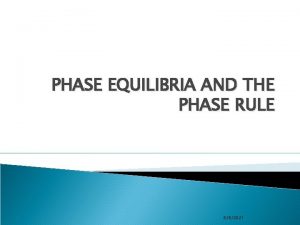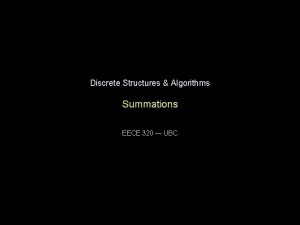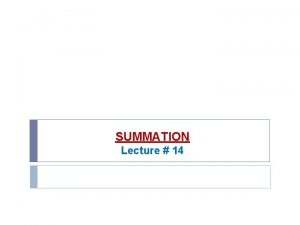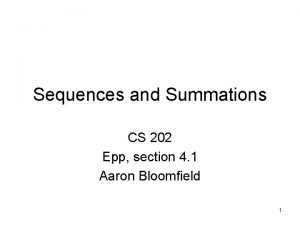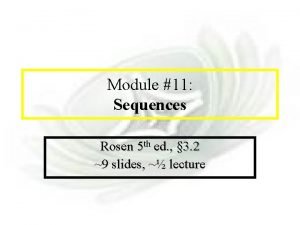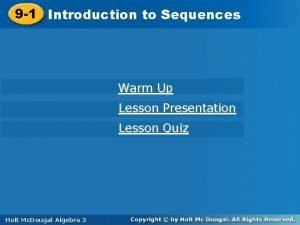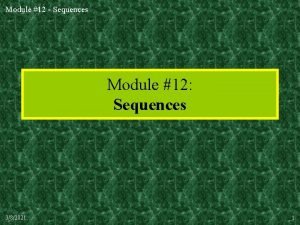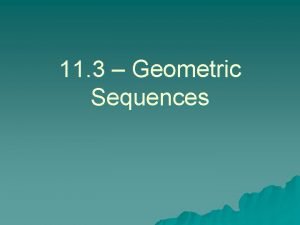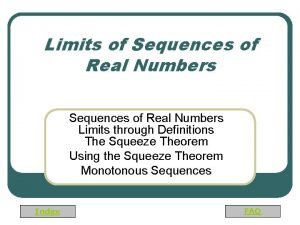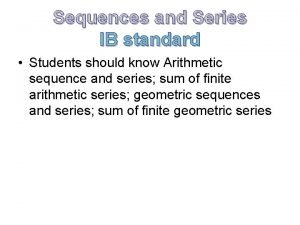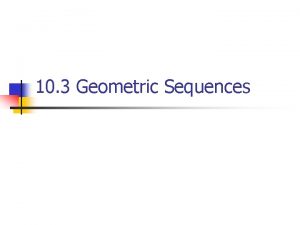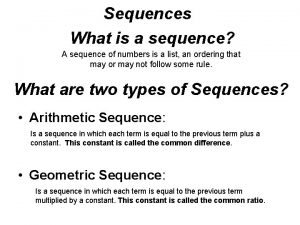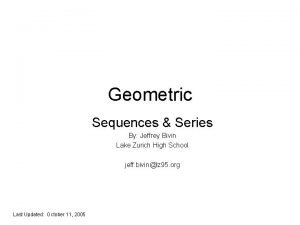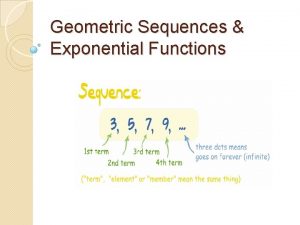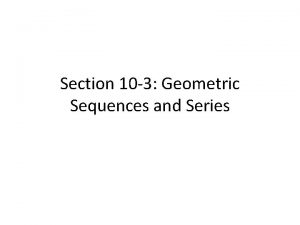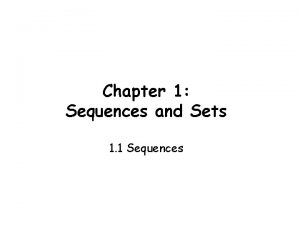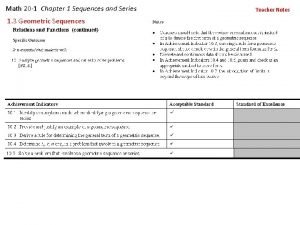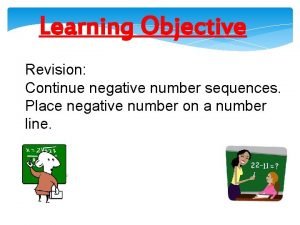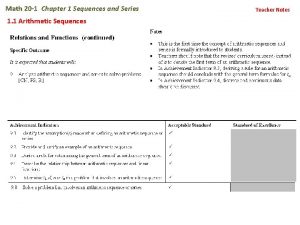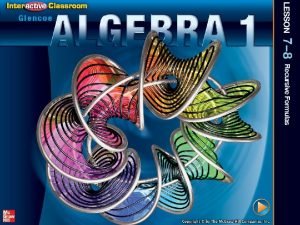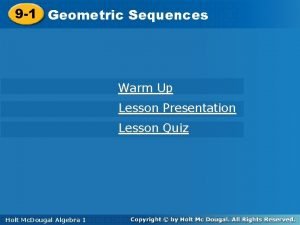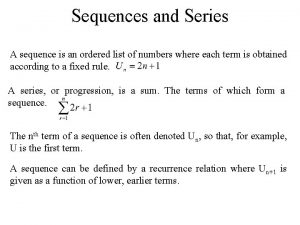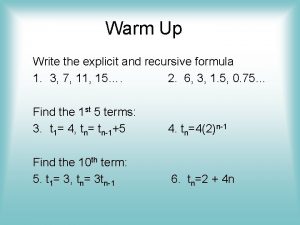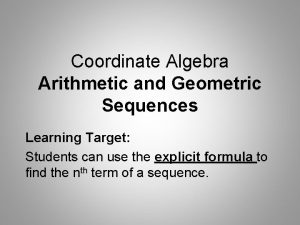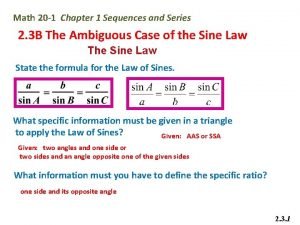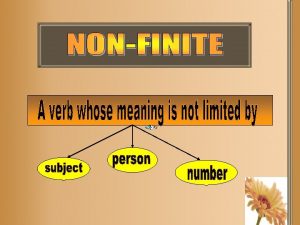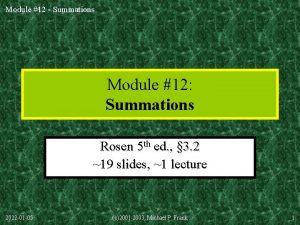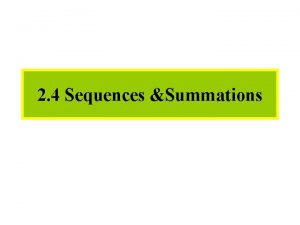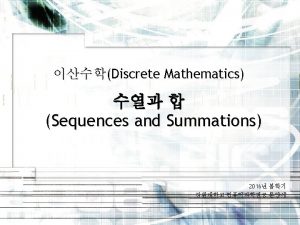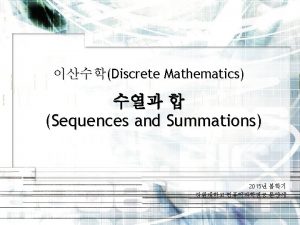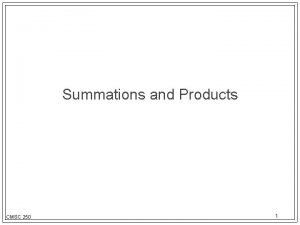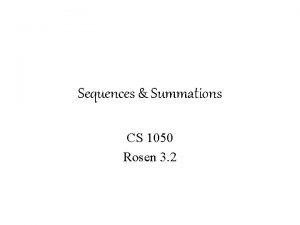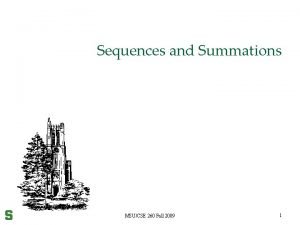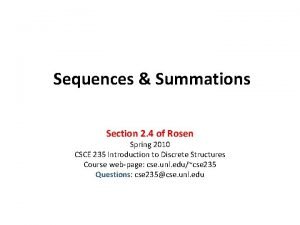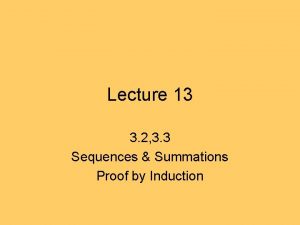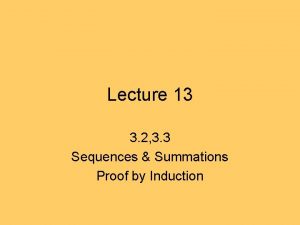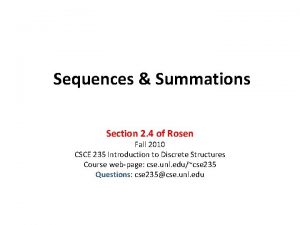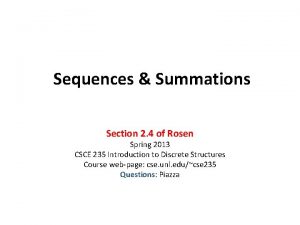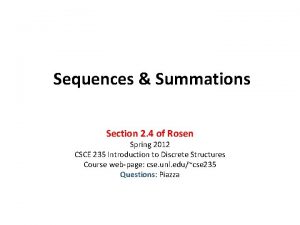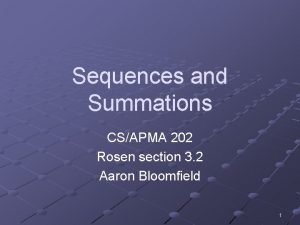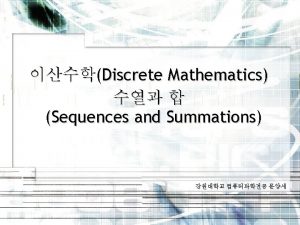Module 12 Sequences 2 4 Sequences Summations 662021
































- Slides: 32

Module #12 - Sequences 2. 4 Sequences &Summations 6/6/2021 1

Module #12 - Sequences, Strings, & Summations • A sequence or series is just like an ordered ntuple, except: – Each element in the series has an associated index number. – A sequence or series may be infinite. • A string is a sequence of symbols from some finite alphabet. • A summation is a compact notation for the sum of all terms in a (possibly infinite) series. 6/6/2021 2

Module #12 - Sequences • A sequence or series {an} : is a sequence and an is a term of the sequence Sequences are described by listing the terms of the sequence in order of increasing subscripts. {an}= a 1, a 2, a 3, a 4, …. . , 6/6/2021 3

Module #12 - Sequences • If f is a generating function for a series {an}, then the symbol an denotes f(n), also called term n of the sequence. – The index of an is n. • A series is sometimes denoted by listing its first and/or last few elements, and using ellipsis (…) notation. – E. g. , “{an} = 0, 1, 4, 9, 16, 25, …” is taken to mean n N, an = n 2. 6/6/2021 4

Module #12 - Sequences Sequence Examples • An example of an infinite series: – Consider the series {an} = a 1, a 2, …, where ( n 1) an= f(n) = 1/n. – Then, we have {an} = 1, 1/2, 1/3, … 6/6/2021 5

Module #12 - Sequences Example with Repetitions • Like tuples, but unlike sets, a sequence may contain repeated instances of an element. • Consider the sequence {bn} = b 0, b 1, … (note that 0 is an index) where bn = ( 1)n. – Thus, {bn} = 1, 1, … • Note repetitions! – This {bn} denotes an infinite sequence of 1’s and 1’s, not the 2 -element set {1, 1}. 6/6/2021 6

Module #12 - Sequences are two types: • Geometric progression: it is a sequence of form a, ar 2, ar 3 ………, arn where the initial term is a and the common ratio r are real numbers. • Arithmetic progression: it is a sequence of form a, a+d, a+2 d, ………, a + nd where the initial term a and the common difference d are real numbers 6/6/2021 7

Module #12 - Sequences Examples of Geometric Example 1: {bn } with bn = (-1)n , n>=1 list of terms: b 1, b 2, ……are: -1, 1, ……. . – initial term = -1, common ratio= -1, Example 2: {Cn} with Cn = 2× 5 n , n>=1 list of terms: C 1, C 2, C 3, . . . are: 10, 50, 250, 1250, ………. – initial term = 10, common ratio= 5 6/6/2021 8

Module #12 - Sequences Examples of Geometric Example 3: {dn } with dn = 6×(1/3)n , n>=0 list of terms: d 1, d 2, d 3, d 4, . . Are: 2, 2/3, 2/9, 2/27, . . . – initial term = 2, common ratio= 1/3 6/6/2021 9

Module #12 - Sequences Examples of Arithmetic Example 1: {Sn} with Sn = -1 + 4 n, n ≥ 0 is arithmetic sequence where the list of terms : s 0, s 1, s 2, s 3, s 4, . . . are: Sn = -1, 3, 7, 11, … OR Sn = sn-1+4, S 0=-1, n ≥ 0 – initial term = -1, common Difference= 4 Example 2: {an } with an = 6 n – 1 , n ≥ 1 The sequence : 5, 11, 17, 23, 29 … is arithmetic progression where: initial term = 5, common Difference= 6 6/6/2021 10

Module #12 - Sequences Examples of Arithmetic Example 3: {tn} with tn = 7 - 3 n, n ≥ 0 is arithmetic sequence where the list of terms : t 0, t 1, t 2, t 3, t 4, . . . are: tn = 7, 4, 1, -2 , . . . – initial term = 7, common Difference= -3 tn = tn-1 +-3 , t 0 =7 6/6/2021 11

Module #12 - Sequences Recognizing Sequences • Sometimes, you’re given the first few terms of a sequence, – and you are asked to find the sequence’s generating function, – or a procedure to generate the sequence. • Examples: What’s the next number? – 1, 2, 3, 4, … – 1, 3, 5, 7, 9, … – 2, 3, 5, 7, 11, . . . 6/6/2021 5 (the 5 th smallest number >0) 11 (the 6 th smallest odd number >0) 13 (the 6 th smallest prime number) 12

Module #12 - Sequences Example • Find the formula the following sequence: 1, ½, ¼, 1/8, 1/16, …… {an} with an = 1/2 n-1 , n>=1 (OR 1/2 n n>=0) it’s a geometric progression where: initial term a is 1 , common ratio r is 1/2 6/6/2021 13

Module #12 - Sequences Example • Find the formula the following sequence: 1, 3 , 5, 7, 9, …… {an} with an = 2 n-1 , n>0 (Or 2 n+1 when n>=0) the sequence is an arithmetic progression where: initial term a is 1 , common difference d is 2 6/6/2021 14

Module #12 - Sequences Some Useful Sequences nth term n 2 n 3 2 n n! 6/6/2021 First 5 terms 1, 4, 9, 16, 25, …. . 1, 8, 27, 64, 125, …. 2, 4, 8, 16, 32, 64, …. 1, 2, 6, 24, 120, …. 15

Module #12 - Sequences Example: Find the formula the following sequence: 2, 5, 10, 17, 26, …. . {an} where an = n 2 +1 Because: n 2 is 1, 4, 9, 16, 25, …. . 6/6/2021 16

Module #12 - Sequences Summations 6/6/2021 17

Module #12 - Sequences Summation Notation • Given a series {an}, an integer lower bound (or limit) j 0, and an integer upper bound k j, then the summation of {an} from j to k is written and defined as follows: • Here, i is called the index of summation. 6/6/2021 18

Module #12 - Sequences Generalized Summations • For an infinite series, we may write: • To sum a function over all members of a set X={x 1, x 2, …}: • Or, if X={x|P(x)}, we may just write: 6/6/2021 19

Module #12 - Sequences Simple Summation Example 6/6/2021 20

Module #12 - Sequences More Summation Examples Using a predicate to define a set of elements to sum over: 6/6/2021 21

Module #12 - Sequences Summation Manipulations • Some handy identities for summations: (Distributive law. ) (Application of commutativity. ) (Index shifting. ) 6/6/2021 22

Module #12 - Sequences More Summation Manipulations • Other identities that are sometimes useful: (Series splitting. ) 6/6/2021 23

Module #12 - Sequences Nested Summations • These have the meaning you’d expect. • Note issues of free vs. bound variables, just like in quantified expressions, integrals, etc. 6/6/2021 24

Module #12 - Sequences Some Shortcut Expressions(1) Geometric series. Euler’s trick. Quadratic series. Cubic series. 6/6/2021 25

Module #12 - Sequences Some Shortcut Expressions(2) 6/6/2021 26

Module #12 - Sequences Using the Shortcuts • Example: Evaluate . – Use series splitting. – Solve for desired summation. – Apply quadratic series rule. – Evaluate. 6/6/2021 27

Module #12 - Sequences Example 6/6/2021 28

Module #12 - Sequences Examples • Find = n(n+1)/2 – n(n+1)/2 = (200)(201)/2 – (99)(100)/2 =15150 6/6/2021 29

Module #12 - Sequences Example • Find: 6/6/2021 30

Module #12 - Sequences Example • Find 6/6/2021 31

Module #12 - Sequences Example • Find : An infinite series with a finite sum: 6/6/2021 32
 Two component system containing liquid phase
Two component system containing liquid phase Harmonic number
Harmonic number Splitting up summations
Splitting up summations Closed form summation
Closed form summation Summation notation
Summation notation Summations
Summations Module 4 patterns and sequences
Module 4 patterns and sequences Patterns and sequences module quiz b
Patterns and sequences module quiz b Module 12 sequences and series
Module 12 sequences and series C device module module 1
C device module module 1 9-3 geometric sequences
9-3 geometric sequences How to calculate nth term
How to calculate nth term Limits of sequences
Limits of sequences Series in calculus
Series in calculus Geometric sequence example
Geometric sequence example Sum of gp formula
Sum of gp formula Geometric sequences
Geometric sequences The sequence
The sequence Sum of arithmetic progression formula
Sum of arithmetic progression formula Geometric sequences
Geometric sequences Geometric sequence vs exponential function
Geometric sequence vs exponential function Compare two sequences
Compare two sequences 10-3 geometric sequences and series
10-3 geometric sequences and series Arithmetic sequence sigma notation
Arithmetic sequence sigma notation Geometric sequences formula
Geometric sequences formula Negative number sequences
Negative number sequences Geometric sequence
Geometric sequence Lesson 2 recursive formulas for sequences
Lesson 2 recursive formulas for sequences 9-1 geometric sequences
9-1 geometric sequences Proof of arithmetic series formula
Proof of arithmetic series formula Difference between recursive and explicit formula
Difference between recursive and explicit formula Geometric and arithmetic sequences formulas
Geometric and arithmetic sequences formulas Sequences and series math 20-1
Sequences and series math 20-1
